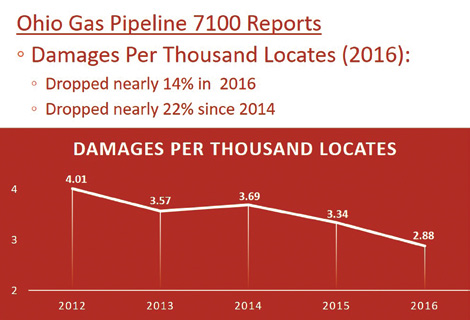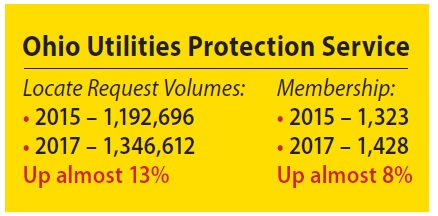
On January 1, 2016, Ohio began its new enforcement provision for excavating near underground utilities. Ten years in the making, it was time to put all the hard work of creating the enforcement structure into actual practice. Since many states are trending towards this process, we shared what we did with our One Call law, our experience of implementation, tools we incorporated to help this process flow smoothly, our experiences with the Public Utilities Commission and what we have found since the inception.
What Did We Do?
To fully understand how we implemented the enforcement, what we are enforcing needs to be discussed.
First, simply violating the One Call law is subject to enforcement. Damage to a facility is not a prerequisite for enforcement proceedings. The idea behind this was that we not only want to change behavior, but we want to minimize the risk associated with damages (i.e., attempt to change behavior before a damage occurs).
Second, all facilities are subject to enforcement for violations. This includes previous facilities that normally did not interact with the Public Utilities Commission, (PUC). This was not an easy idea to sell. However, the purpose of enforcing all facilities is, once again, to change behaviors of all groups, not just a specific group of facility owners.
Third, all stakeholders are subject to enforcement, including excavators, municipalities, designers, project owners, etc. Basically, if you have an obligation under the One Call law, you are held accountable for those obligations. The reason behind this all-encompassing enforcement process is the belief that damage prevention is truly a shared responsibility. Essentially, any “misstep” or lack of fulfillment of obligations in the stakeholder responsibility matrix greatly increases the likelihood of damage.
This shared responsibility ideal was incorporated into the funding structure for the enforcement agent. All stakeholders are assessed a small fee from the PUC. The first year, the assessment was $25. This generated enough resources that assessments for 2017 and 2018 were zero. Further, we avoided the potholes of dependency of funding through penalties, grants that are not guaranteed into the future or assessing just one stakeholder that has responsibilities under the law.
Finally, our biggest change was naming the Public Utilities Commission as the enforcement agent. Once again, many stakeholders were concerned that they had not previously been under the authority of the PUC. This was addressed in three parts. First, the driving force behind selecting the PUC was to leverage current capabilities of the agency: reporting, investigations, escalation structure, appeal/hearing process, and ability to issue and collect fines (i.e., we did not have to reinvent the wheel because the process was already in place and ran smoothly). Second, what the PUC could enforce was defined clearly in the law. This eliminated the fear of “reach” into areas of stakeholder group operations that was never the intent of the law. Third, the Underground Technical Committee (UTC) was created. The UTC is made up of 17 members representing 14 industries, including four excavator representatives, to eliminate potential “industry” bias. Representatives were appointed to serve as subject matter experts and to assist the PUC in carrying out its duties under the One Call law. The establishment of the committee contributes to the acceptance of the enforcement process by eliminating the fear that the authority could lack direct knowledge on all aspects of the One Call process. In other words, it truly is a decision of peers.
Implementation Process
The implementation process of the UTC was a surprisingly smooth transition. This was attributable to several factors. First, since members are appointed, early engagement of legislators was crucial to ensure we had a full functioning committee. Second, the committee members conducted extensive research. We reviewed other states that had similar committees and met with them to learn what worked and what didn’t work so well. (Special note: this other committee research was not conducted solely on One Call committees, but instead on any committee that had successful results.) Research in hand, we began the next step in the development of the committee, establishing our main group agenda. We found that successful committees had a cohesive foundation to build on and, now, so do we — safety.
Next, we needed to determine how to avoid the huge issue of potential stalemate decisions. We accomplished this by looking at the decision process itself. In a potential violation, we determined that there are two decisions that need to be considered. Was there a violation? And, if so, what is the penalty? Accordingly, the decision-making process for violation recommendation was broken into two parts. First, the committee reviews the incident and determines, by vote, if there was a violation. Next, if the violation is valid, a separate discussion and vote for recommended penalty is held. The impact of this is evident as the need for roll call/consensus voting has not circled around the question of violation, but the question of type of penalty/penalty amount.

Figure 1
The selection of the PUC as the enforcement agent has significantly contributed to the success of the committee. With processes already in place, by the second meeting the PUC had provided us with handbooks that included all laws, marking standards, One Call codes, ethics policy, and public meeting rules. Having all this information at hand has been key to many discussions, as you will often hear at the meetings, “what page is that on? Oh, I see what you mean.” Also, the PUC provided an electronic database for all case files. Having a “one stop shop” for all the information has really helped our committee stay organized and focused. Finally, we have the benefit of PUC legal personnel that we can ask questions when things get “cloudy.”

Figure 2
Proof is in the Pudding
It is difficult to measure what factor is the primary cause of change in effective damage prevention programs. This is because there are many factors that must be in place for a program to succeed. We discussed the importance of shared responsibility in the terms that all stakeholders that have obligations in the One Call process must fulfill those obligations or increase the potential of the process failing. Another key factor is public education. Stakeholders must know and understand their obligations to fulfill those obligations. Keeping this in mind, we took information prior to enforcement being in place and compared it to what is happening now.
First, the pie chart of alleged violation categories for 2017 (Figure 1) show that violations to the One Call law are not attributable to one stakeholder group or one obligation. Focus on education must be multifaceted to include all stakeholder groups to achieve effective damage prevention.

Figure 3
Next, we found that damages per 1,000 locates has decreased by 14% since 2016 for gas pipeline in Ohio (Figure 2). Further, locate request volume and membership to the One Call center has also increased (Figure 3).
This means behavior is changing in Ohio. When all stakeholders fulfill their obligations under the One Call process, it decreases the likelihood of damage and we are seeing this decrease.
In Ohio, we are continuing to make strides to ensure that excavation near facilities is safer for the worker, the utility and the public. The steps we have taken in the last three years are already showing changes in behavior and we are optimistic that this change will grow through the coming years. Our meetings are open to the public and the schedule can be found at https://www.puco.ohio.gov/ if you would like to attend to experience our process first hand.
This article summarizes the presentation of Robert Fadley, Public Utilities Commission of Ohio; David Losinski, American Electric Power, and Jennifer Reams, Infrastructure Compliance Concepts at the 2018 CGA 811 Excavation Safety Conference & Expo.

![ESM Sidebar Ad[87] ESM Sidebar Ad[87]](https://excavationsafetyalliance.com/hubfs/ESM%20Sidebar%20Ad%5B87%5D.gif)



Comments